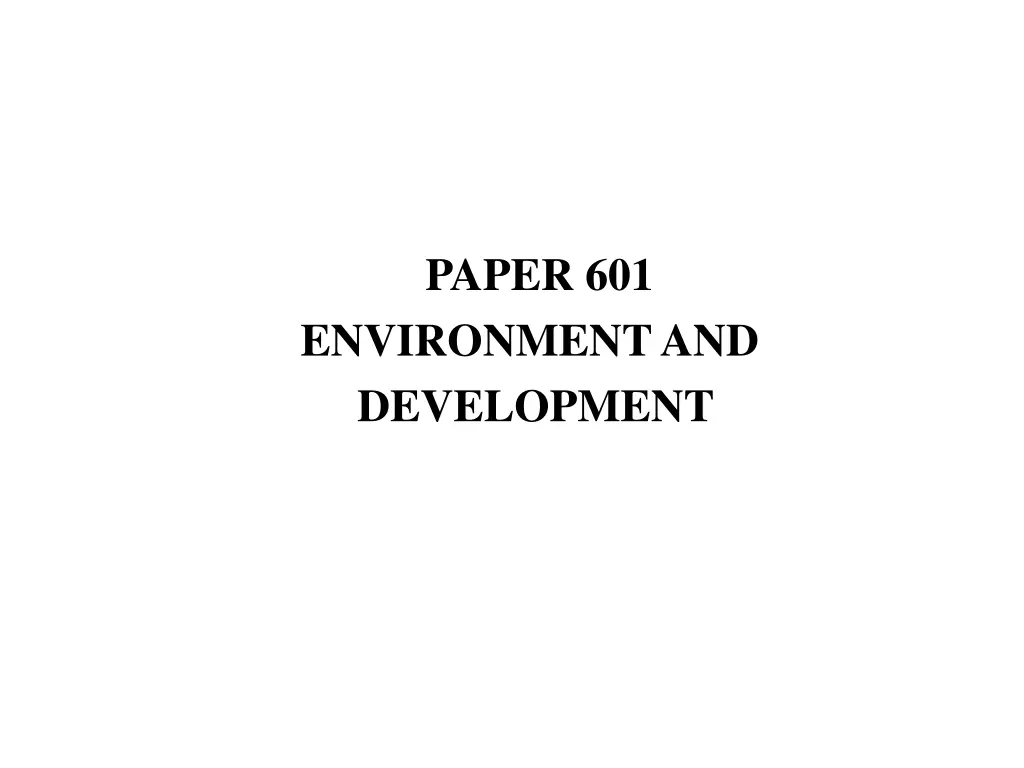
Geography in Environmental Education
Geography plays a crucial role in understanding human-space interaction and its impact on the environment. This article explores the challenges posed by human activities to the natural environment, such as deforestation, pollution, and climate change. It emphasizes the importance of environmental education in promoting sustainable practices and raising awareness about the value of natural resources. By integrating geography into education, individuals can develop a holistic perspective on environmental issues and work towards a more sustainable future.
Download Presentation

Please find below an Image/Link to download the presentation.
The content on the website is provided AS IS for your information and personal use only. It may not be sold, licensed, or shared on other websites without obtaining consent from the author. If you encounter any issues during the download, it is possible that the publisher has removed the file from their server.
You are allowed to download the files provided on this website for personal or commercial use, subject to the condition that they are used lawfully. All files are the property of their respective owners.
The content on the website is provided AS IS for your information and personal use only. It may not be sold, licensed, or shared on other websites without obtaining consent from the author.
E N D
Presentation Transcript
PAPER 601 ENVIRONMENT AND DEVELOPMENT
UNIT 3-Management of environment and development:Role of Geography Geography is the science which studies the human-space interaction according to the principle of cause and effect, and it deals with space and human who uses it for economic purposes When we look at the current perception of the environment and the related application, the present state is not very encouraging Many human activities are as such that leads to irreversible damages to the natural environment.
Few examples such as field grabbing race in polar regions under the pretext of researching, construction of technological cities in desert areas. Destruction of tropical forests for agriculture and settlement purposes, oil drilling practices in the open seas, increasing presence of nuclear facilities and so on. Misapplication of human activities such as settlement and industrialization, mankind confronts such an unhealthy environment where the soil lost all contact with the sky
Global warming, extreme pollution in the atmosphere and hydrographic elements Ever-increasing world population creates the biggest problem that prevents sustainable use of scarce resources With an effective environmental education, it is possible to prevent the excessive and improper use which nature cannot compensate anymore In this respect, the question of how to use the natural environment, how to plan and how to ensure environmental awareness in large populations come to the fore
In order to answer these questions it is necessary to know the structure and the properties of the natural environment for the first place. At this point, the place of geography comes to the fore in an effective environmental education. Geography along with other disciplines plays an important part in environmental education, which helps people acquire the awareness of the earth, natural resources and their value.
Geography as a holistic discipline deals with the natural mechanism, investigates human and economic activities together with the interaction between man and nature and helps individuals adopt a holistic viewpoint. As is known, geography is a positive science based on cause and effect dichotomy and investigating the interaction between human space from the widest perspective. Therefore, its function is to provide individuals with the data on the operational mechanism of the nature and the activities of humans who benefit from this.
From this viewpoint, geography attached a greater importance in environmental education. Geography is considered as a major factor of environmental education as it helps in revealing natural and human factors causing environmental problems. By this way,geography contributes to the achievement of the behavioural change intended in the environmental education by establishing a cause-effect relationship.
The increase of geographical studies in environmental education is supposed to help these area become sustainable economic area,pass down cultural values to next generation,raise environment awareness etc. The knowledge of environmental geography helps in developing a behavioral changes and the intended increase in information which helps to raise an individual who can read maps,interpret the environmental ecology where one can live according to basic geographical principles.
As is known,geography is a positive science based on cause-and-effect Dichotomy and investigating the interaction between Human and space from the wider perspective. It helps in identifying over and under ground resources,analyza envitonmental problems through causality and hence develop a holistic approach toward any environmental problem.
According to Hartshorne (1939) geography is the science that provides accurate, orderly and rational description of the variable character of the earth surface. This definition emphasizes that everything on this earth has a geographic dimension as everything is place specific and changing from place to place. Thus, management is also a geographic phenomenon, as managerial methods, practices and decisions also change from place to place.
They are time and place specific and acting as processes changing over time and space which are emphasized as identities in geography. At present, geographical concepts are significantly applied in management, particularly in environmental management. Environmental management involves the management of all components of the bio- physical environment, both living (biotic) and nonliving (abiotic).
Geographers and environmental managers are concerned with the world around us, exploring how with we can balance societies needs without compromising our natural environment Geography and Environmental Management studies the total human-nature system with the purpose to understand and manage land use patterns and the influences thereof on the environment Therefore geography plays a prominent role in management of environment
